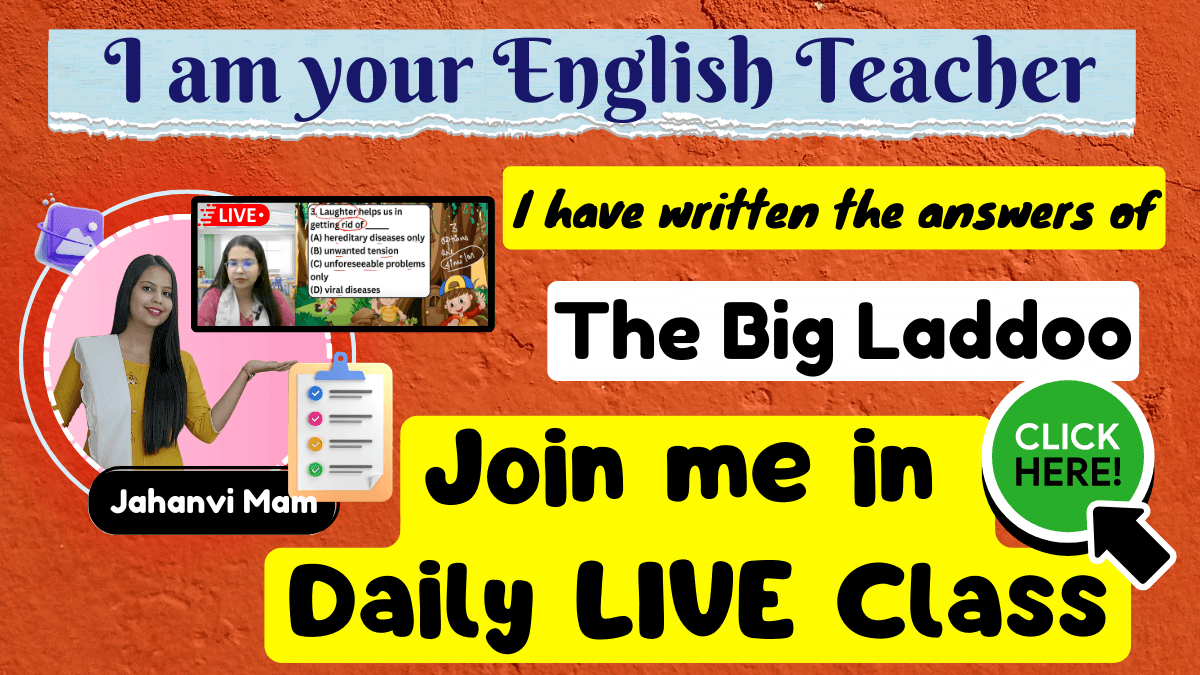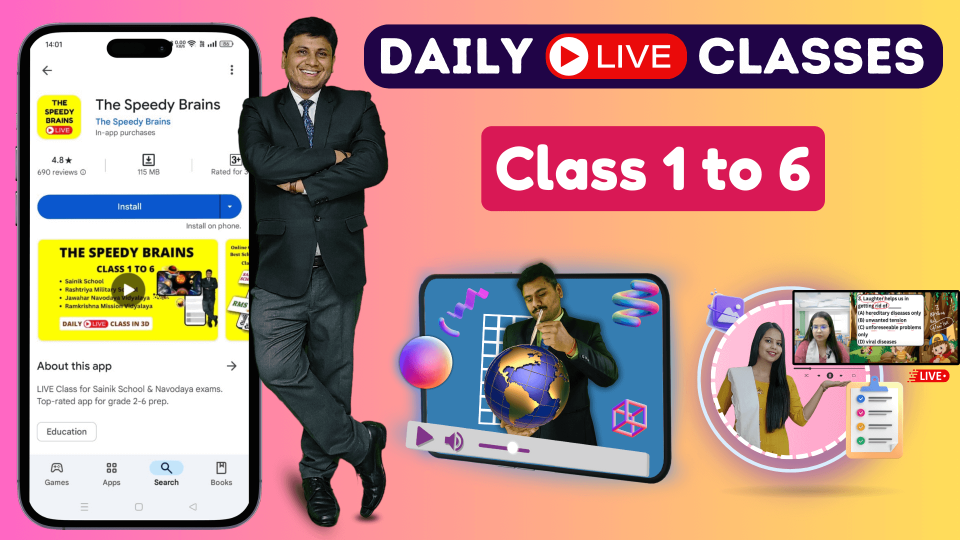The Big Laddoo - Class 3 English NCERT Solution
The Big Laddoo from Class 3 English NCERT is a playful poem that invites children to imagine everything as big—laddoos, children, and even the sea. The poem encourages imagination and creativity in young readers. This page provides vocabulary lists, solutions, and extra questions to help students understand the poem better, making it both enjoyable and educational.
Gist or Summary of the Poem "The Big Laddoo"
Summary in English:
The poem "The Big Laddoo" is a playful exploration of imagination and size. It asks readers to envision what would happen if all individual things of a kind were combined into one enormous entity. The poem starts by imagining all laddoos (a popular Indian sweet) becoming one giant laddoo, then all children becoming one big child, and all seas merging into one massive sea. The climax of the poem describes the imaginary scenario of this giant child throwing the enormous laddoo into the huge sea, creating a tremendous splash. This whimsical poem encourages children to think creatively and visualize impossible, larger-than-life situations, making it both fun and thought-provoking.
हिंदी में सारांश:
"द बिग लड्डू" कविता कल्पना और आकार की एक मजेदार खोज है। यह पाठकों से यह सोचने को कहती है कि क्या होगा अगर एक तरह की सभी व्यक्तिगत चीजें मिलकर एक विशाल वस्तु बन जाएं। कविता सभी लड्डुओं (एक लोकप्रिय भारतीय मिठाई) के एक विशाल लड्डू बनने की कल्पना से शुरू होती है, फिर सभी बच्चों के एक बड़े बच्चे में बदलने, और सभी समुद्रों के एक विशाल समुद्र में मिलने की बात करती है। कविता का चरम बिंदु इस काल्पनिक परिदृश्य का वर्णन करता है जहां यह विशाल बच्चा विशाल लड्डू को विशाल समुद्र में फेंकता है, जिससे एक बहुत बड़ी छप-छप की आवाज़ होती है। यह मनमौजी कविता बच्चों को रचनात्मक रूप से सोचने और असंभव, जीवन से बड़ी परिस्थितियों की कल्पना करने के लिए प्रोत्साहित करती है, जो इसे मजेदार और विचारोत्तेजक दोनों बनाती है।
Word Meanings
| Sl | English Word | Hindi Meaning | English Meaning |
|---|---|---|---|
| 1 | Laddoo | लड्डू | A round sweet made of flour, sugar, and other ingredients |
| 2 | Sea | समुद्र | A large body of saltwater |
| 3 | Splish-splash | छप-छप | The sound of water splashing |
| 4 | Harvest | फसल | The process of gathering crops |
| 5 | Festival | त्योहार | A day or period of celebration |
| 6 | Khichdi | खिचड़ी | A dish made from rice and lentils |
| 7 | Lentils | दाल | A type of legume |
| 8 | Float | तैरना | To remain on the surface of a liquid |
| 9 | Sink | डूबना | To go down below the surface of a liquid |
| 10 | Kites | पतंग | A light frame covered with paper or cloth, flown in the wind |
Exercise Solutions
1. Have you seen a big laddoo? How big was it? Did you eat it all by yourself? Tell your friends about it.
This is a subjective question, but here's a sample answer: Yes, I have seen a big laddoo at a festival. It was about the size of a cricket ball. I couldn't eat it all by myself because it was too big and sweet. I shared it with my family members, and we all enjoyed it together.
2. Have you eaten anything that is very big? What was it? Talk about it.
This is a subjective question, but here's a sample answer: Once, I ate a very big dosa at a restaurant. It was called a 'Family Dosa' and was about 3 feet long! It was crispy and delicious, filled with potato masala. My whole family shared it, and it was a fun experience to eat such a big dosa together.
3. What different kinds of laddoos have you eaten?
This is a subjective question, but here's a sample answer: I have eaten several types of laddoos: - Boondi laddoo (made from small fried droplets of besan batter) - Motichoor laddoo (similar to boondi, but with smaller droplets) - Besan laddoo (made from roasted gram flour) - Rava laddoo (made from semolina) - Coconut laddoo (made from grated coconut) Each type has its unique flavor and texture.
4. Name a few things that are round in shape. Can you eat all of them? Write them in the correct column.
Here's a sample answer: That can be eaten: - Apple - Orange - Guava - Tomato - Boondi laddoo That cannot be eaten: - Ball - Globe - Marble - Button - Coin
5. The child threw the Big Laddoo into the sea. What do you think happened to the Laddoo?
When the big laddoo was thrown into the sea, it would have created a big splash as mentioned in the poem - "Oh! What a BIG SPLISH-SPLASH it would be!" After that, the laddoo would start to dissolve in the water. Since laddoos are made of sugar and other ingredients that can dissolve in water, the big laddoo would slowly break apart and mix with the seawater. Eventually, it would completely disappear, leaving only a sweet taste in that part of the sea.
Jithu and Meena are friends. Meena cannot see properly. It was her birthday. Jithu gifted her a box of mixed sweets. She felt the sweets and excitedly picked up the big laddoo. She said, "I love laddoos!" Jithu was surprised and asked her, "How did you know it was a laddoo?" Think and say what Meena answered.
Meena might have answered: "I could tell it was a laddoo by its round shape and slightly rough texture. Laddoos have a unique feel that's different from other sweets. When I touched it, I could feel its roundness and the tiny bumps on its surface, which are typical of laddoos. Also, laddoos are usually bigger than other sweets in a mixed box, so when I felt the largest sweet, I knew it must be a laddoo!"
Laddoos are sweets, commonly eaten in every house. Write words that tell us about the laddoo.
Here are some words that describe laddoos: - Sweet - Round - Delicious - Festive - Colorful - Fragrant - Traditional - Sugary - Mouthwatering - Celebratory
Additional Short Answer Questions
1. What is the main idea of the poem "The Big Laddoo"?
The main idea of the poem is to imagine what would happen if all individual things of a kind were combined into one big thing. It uses examples like all laddoos becoming one big laddoo, all children becoming one big child, and all seas becoming one big sea. The poem ends with a playful image of what would happen if the big child threw the big laddoo into the big sea.
2. Why do you think the poet chose a laddoo for this poem?
The poet likely chose a laddoo because it's a popular sweet in India that children love. Laddoos are round and can easily be imagined as growing bigger, making them a good choice for the poem's concept. Also, laddoos are often associated with celebrations and joy, which adds a fun element to the poem.
3. What would happen if all the laddoos were one laddoo, according to the poem?
According to the poem, if all the laddoos were one laddoo, it would be a very big laddoo. The poem says, "Oh! What a BIG Laddoo it would be!"
4. How does the poem create a sense of increasing size?
The poem creates a sense of increasing size by repeatedly using the word "BIG" in capital letters. It starts with imagining big individual things (laddoo, child, sea) and then combines them into an even bigger scene where the big child throws the big laddoo into the big sea, creating a "BIG SPLISH-SPLASH".
5. What do you think the "SPLISH-SPLASH" at the end of the poem represents?
The "SPLISH-SPLASH" at the end of the poem represents the enormous sound and impact that would be created if a giant laddoo were thrown into a giant sea by a giant child. It's the climax of the poem, bringing together all the "big" elements in a fun, imaginative way.
6. How does this poem encourage imagination?
This poem encourages imagination by asking readers to visualize impossible scenarios, like all laddoos becoming one giant laddoo or all children becoming one giant child. It invites children to think beyond reality and imagine funny, exaggerated situations.
7. What is a khichdi, and why is it mentioned in the chapter?
Khichdi is a popular Indian dish made from rice and lentils cooked together. It's mentioned in the chapter because it's a traditional dish prepared during festivals, especially during Sankranti. The chapter talks about how different regions in India have their own versions of khichdi, showing the diversity of Indian cuisine.
8. What is Sankranti, and how is it celebrated?
Sankranti is a harvest festival celebrated in India. It's known by different names in various parts of the country, such as Pongal, Lohri, and Bihu. People celebrate it to thank the Sun God for a good harvest. Flying kites is a popular activity during this festival in many regions.
9. Why are festivals important, according to the chapter?
According to the chapter, festivals are important because they keep us connected with nature and culture. They help people stay together, bringing happiness, joy, and smiles. Festivals also involve special food preparations, which can vary across different regions of India.
10. What experiment does the chapter suggest with various objects and water?
The chapter suggests an experiment where children put different objects into a tub of water to see which ones float and which ones sink. Objects mentioned include a piece of paper, a small stone, a green leaf, a pencil, an eraser, a feather, and a spoon. This experiment helps children understand the concepts of floating and sinking.
11. How does the chapter connect sweets with festivals?
The chapter mentions that not only sweets but also other special dishes are prepared during festivals. It uses the example of khichdi, which is cooked during the Sankranti festival. This shows how food, especially sweets and traditional dishes, plays an important role in festival celebrations.
12. What are some different names for khichdi mentioned in the chapter?
The chapter mentions several regional names for khichdi: - Gujarati khichdi in Gujarat - Pongal in Tamil Nadu - Bihari khichdi in Bihar - Bajra khichdi in Rajasthan - Kichuri in West Bengal - Bisi bele bhat in Karnataka - Moong khetchir in Kashmir This shows how the same basic dish can have different names and variations across India.
The Speedy Brains APP Download
Over 15000 students from all over India rely on our The Speedy Brains App for their School Exams. 850 Satisfied students have given 5 star review to our Android app on Google Play Store.
- Best Online LIVE Class APP
- Live Class Recordings
- Unlimited Practice Tests
- Previous Year Questions
- 800+ 5star Ratings

